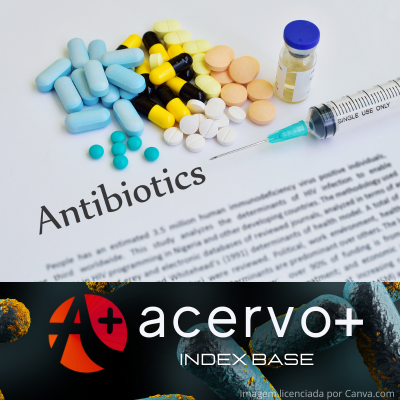Programa de Gerenciamento da Terapia Antimicrobiana em um hospital: indicadores e estudo farmacoeconônico
##plugins.themes.bootstrap3.article.main##
Resumo
Objetivo: Descrever o estudo farmacoeconômico de um Programa de Gerenciamento da Terapia Antimicrobiana realizado em um hospital. Métodos: Estudo nos anos de 2019 a 2021, do tipo exploratório, descritivo e quantitativo, sobre um Programa de gerenciamento, trazendo a intervenção proposta baseada na auditoria prospectiva da terapia antimicrobiana, revelando seus dados em forma de indicadores. Aplicado a análise do tipo custo-minimização. Os dados foram analisados por estatística descritiva com auxílio do software IBM SPSS Statistics. O estudo foi aprovado por Comitê de Ética em Pesquisa. Resultados: Foram acompanhados 2993 pacientes. Nos achados, uma média de uso de 2,5 antimicrobianos, 1,6 estratégias propostas por paciente e taxa de aceitação de 97,4% (n= 5718). A média da taxa de custo direto minimizado foi de 32,5% (R$ 68.407,21) por mês, e de R$ 685,67 economizados por cada paciente. Ainda foi estimado que se o estudo tivesse uma cobertura total de leitos desde o início da implantação do Programa, isto poderia incrementar em 17,2% (R$ 353.220,61) o custo direto minimizado total do estudo. Conclusão: O Programa se mostrou eficaz quanto à redução no custo direto de antimicrobianos através das estratégias propostas pela equipe multidisciplinar.
##plugins.themes.bootstrap3.article.details##
Copyright © | Todos os direitos reservados.
A revista detém os direitos autorais exclusivos de publicação deste artigo nos termos da lei 9610/98.
Reprodução parcial
É livre o uso de partes do texto, figuras e questionário do artigo, sendo obrigatória a citação dos autores e revista.
Reprodução total
É expressamente proibida, devendo ser autorizada pela revista.
Referências
2. CONOVER, WJ. 1971. Practical nonparametric statistics. London, Sidney: Wiley & Sons. 462p.
3. CRESPO-RIVAS JC, et al. Are antimicrobial stewardship interventions effective and safe in long-term care facilities? A systematic review and meta-analysis. Clinical microbiology and infection: the official publication of the European Society of Clinical Microbiology and Infectious Diseases, 2021; 27(10): 1431-1438.
4. DE WAELE J, et al. Antimicrobial de-escalation as part of antimicrobial stewardship in intensive care: no simple answers to simple questions - a viewpoint of experts. Intensive Care Med, 2020; 46: 236 – 244.
5. Diretriz Nacional para Elaboração de Programa de Gerenciamento do Uso de Antimicrobianos em Serviços de Saúde. Agência Nacional de Vigilância Sanitária. Brasília, p. 96 dez, 2017. Disponível em: https://antigo.anvisa.gov.br/documents/33852/271855/Diretriz+Nacional+para+ Elabora%C3%A7%C3%A3o+de+Programa+de+Gerenciamento+do+Uso+de+Antimicrobianos+em+Servi%C3%A7os+de+Sa%C3%BAde/667979c2-7edc-411b-a7e0-49a6448880d4?version=1.0. Acessado em: 15 de outubro de 2022.
6. KHDOUR M, et al. Impact of antimicrobial stewardship programme on hospitalized patients at the intensive care unit: a prospective audit and feedback study. British Journal of Clinical Pharmacology, 2018; 84: 708-715.
7. HOLGUÍN H, et al. Intervenciones farmacéuticas y desenlaces clínicos en un programa de gerenciamiento de antimicrobianos. Revista Chilena Infectologia, 2020; 37(4): 343-348.
8. HSIEH CL, et al. Intervenciones farmacéuticas y desenlaces clínicos en un programa de gerenciamiento de antimicrobianos. Revista Chilena Infectologia, 2020; 37(4): 343-348.
9. HUTTNER BD, et al. COVID-19: don't neglect antimicrobial stewardship principles! Clinical Microbiology and Infection, 2020; 26: 808-810.
10. LUCIEN MAB, et al. Antibiotics and antimicrobial resistance in the COVID-19 era: Perspective from resource-limited settings. Int J Infect Dis, 2021; 104: 250-254.
11. LYNCH C, et al. Antimicrobial stewardship: a COVID casualty?Journal of Hospital Infection, 2020; 106: 401-403.
12. MENDELSON M, et al. How to start an antimicrobial stewardship programme in a hospital. Clinical Microbiology and Infection, 2020; 26: 447 – 453.
13. MONIZ P, et al. Antimicrobial Stewardship in the Intensive Care Unit: The Role of Biomarkers, Pharmacokinetics, and Pharmacodynamics. Advances in therapy, 2021; 38(1): 164-179.
14. MONTRUCCHIO G, et al. Choosing wisely: what is the actual role of antimicrobial stewardship in Intensive Care Units? Minerva Anestesiologica, 2019; 85: 71-82.
15. NATHWANI D, et al. Value of hospital antimicrobial stewardship programs [ASPs]: a systematic review. Antimicrobial Resistance and Infection Control, 2019; 35(8).
16. TANDAN M, et al. Impact of antimicrobial stewardship program on antimicrobial-resistance and prescribing in nursing homes: a systematic review and meta-analysis. J Glob Antimicrob Resist, 2022; 29: 74-87.
17. TONIN FS, et al. Principles of pharmacoeconomic analysis: the case of pharmacist-led interventions. Pharm Pract (Granada), 2021; 19(1): e2302.
18. TROMBOLD N e AWAD D. The economic opportunity of departmental training during pandemic scenarios: Concepts and analyses. Am J Health Syst Pharm, 2021; 78(23): 2164-2166.
19. VAN DER POL S, et al. Economic Analyses of Respiratory Tract Infection Diagnostics: A Systematic Review. Pharmacoeconomics, 2021; 39(12): 1411-1427.
20. WALLEY T, HAYCOX A. Pharmacoeconomics: basic concepts and terminology. British journal of clinical pharmacology, 1997; 43(4): 343-348.
21. WANG H, et al. Impact of antimicrobial stewardship managed by clinical pharmacists on antibiotic use and drug resistance in a Chinese hospital, 2010-2016: a retrospective observational study. BMJ Open, 2019; 9(8): e026072.

